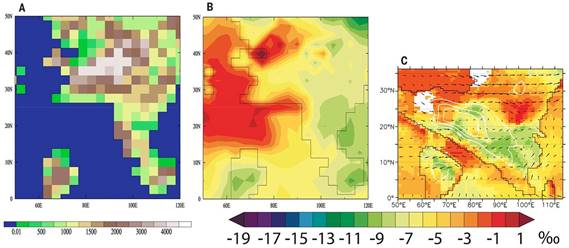
Researchers from the Center for Excellence in Tibetan Plateau Earth Sciences under Institute of Tibetan Plateau Research of the Chinese Academy of Sciences (ITPCAS) and the University of Bristol, along with their collaborators, reported that an extensive Tibetan Plateau exceeding 4000 m above sea level (a.s.l.) existed in middle Eocene.
Their comment paper "Comment on 'Revised paleoaltimetry data show Tibetan Plateau elevation during the Eocene'" focusing on the paleoaltimetry simulation of Tibetan Plateau was published in Science.
The uplifting history of the Tibetan Plateau links together the multisphere interactions among the geodynamics in depth, the earth surface process, and the climate change and biodiversity evolution in the Tibetan Plateau. It is significant for the Tibetan Plateau earth system research and interdisciplinary collaboration.
In the comment paper, the HadCM3L model, an isotope-enabled coupled atmosphere-ocean-vegetation model developed by the University of Bristol, was employed to simulate the oxygen isotope of the precipitation in the Tibetan Plateau at several elevation scenarios during the Lutetian period of middle Eocene (48-41 Ma).
The modelling results indicated that the oxygen isotope was depleting as elevation increased, which was consistent with the Rayleigh fractionation model. They also showed that the core of the Tibetan Plateau, mainly including Lhasa and Qiangtang terranes, had already risen over 4000 m a.s.l. in middle Eocene (Fig. 1). The actual paleogeomorphy was probably complex manifested by two high mountains above 4000m sandwiching one low elevation basin.
Botsyun et al. (2019) used LMDZiso model to simulate the distribution of precipitation oxygen isotope in several different paleogeography and elevation scenarios in middle Eocene. Their results indicated that the paleoelevation of Tibetan Plateau was extensively low in middle Eocene (substantially less than 3000 m).
However, the comment paper pointed out several drawbacks of Botsyun et al.: The LMDZiso model was an atmosphere-only climate model with no feedbacks between the atmosphere, vegetation and ocean; they failed to consider the spatial variations in surface ocean isotopic values, which were ultimately the source of the precipitation; the paleolatitude of the Eocene carbonate providing the measured oxygen isotope data has not been properly calibrated; they acquired a positive relationship between the oxygen isotope of precipitation and elevation in the Eocene Tibetan Plateau, which is unrealistic in the modern world.


86-10-68597521 (day)
86-10-68597289 (night)

52 Sanlihe Rd., Xicheng District,
Beijing, China (100864)

